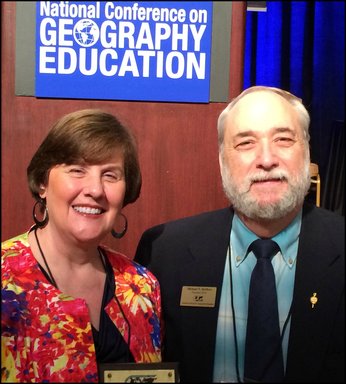I teach Pre-AP World History for 9th grade students and AP Human Geography for 10 -12 at Lawton Chiles High School in Tallahassee, Florida. I have been a member of NCGE for 5 years, since joining the APHG Development Committee. I did not know what a valuable resource I had been missing.
As a junior and senior high school student in rural communities, geography was only a minor part of most social studies classes. I was the first in my family to attend college, where I earned a degree with a double major in History and Criminology at Florida State University. I took a geography and oceanography course as a part of my studies, and although I did not know it at the time, they would become important tools in my still unexpected teaching career. Shortly after graduation, my husband and I moved to Oklahoma where I worked as a Juvenile Counselor.
Working and traveling around Oklahoma was a great geographic experience. After returning to Florida, I began substitute teaching, which eventually lead to my teaching career. I found that I really liked the interaction with the students and felt that I could prevent students from becoming involved in the juvenile justice system while encouraging them to stay in school and create opportunities for themselves.
One of my first assignments was teaching World Regional Geography to sixth grade students. My sixth grade students were not well traveled, but were fascinated by cultures and places that seemed so exotic and so far away. I was also fascinated by a course where we could investigate the Smells of the Rainforest and analyze climagraphs for the Democratic Republic of the Congo. I even had the students design the “Ship of the Desert” using the descriptors of the Camel, without telling them that the “ship of the desert” is actually a camel. Sixth grade students have a vivid imagination! I learned so much geography teaching 6th grade. I used several of my geography lessons to win grants for my classroom. One grant provided a large screen TV (small by today’s standards) and a connection to the one Apple Computer in my classroom. There were no computer labs in those days, so the students were excited to be able to work in groups so they could have one day using the computer for activities like the Amazon Trail or Biking across Africa. We learned together about the spatial layout of the world and the significance of place.
After 15 happy years at middle school, I decided to move to the high school. I found teaching 9th grade geography was not that different from 6th grade geography. The students did not have much background, but were interested and eager to learn. They created wall size maps and used Culturgrams to investigate the world outside of their own domain.
Lawton Chiles High School offers over 20 Advanced Placement Courses. When I learned that there was an AP (Human) Geography course, I was determined to make that my course. I attended an AP Institute lead by Martha Sharma, the APHG guru, who provided the tools and support that I needed to teach the course. Martha’s leadership and support was invaluable to me. The first year, I only had eleven students. Learning to teach the class was challenging, and at one point the students said, “Mrs. Watson, you are killing us!” We took a short break to recover and went on to have a great year. That was eleven years ago, and the numbers in the class grow every year. The students are the best ambassadors for recruiting for the course because they love learning about things they can see in the world around them and how these things relate to the world beyond. I have the students use their smart phone cameras to capture photos that reflect a sense of place, or photos that capture the definition of critical vocabulary of the course. This makes them look differently at the world around them.
In the beginning, I borrowed heavily from the APHG teachers with established courses, like Dan Snyder, who very generously allowed me to use the materials on his website. As I became more proficient in the content, I created my own website (http://www.mrswatsonsclass.com/aphug/) in an effort to support my students and have cheerfully paid it forward as new APHG teachers have come upon and requested the use of my materials.
A friend who was a reader for AP US History encouraged me to become a reader for APHG. It was the best advice I have gotten with regard to teaching the course. In 2006 I became a reader and met a cadre of APHG teachers who love the course as much as I do. Many of the readers were NCGE members, who willingly shared teaching strategies and encouraged joining NCGE.
I made my first presentation at the NCGE in Savannah, then Portland, and this past summer in Memphis, where I was honored to be one of many Distinguished Teachers recognized by the NCGE. These experiences have widened my perspective on geographic thinking and motivated me to learn more for my own teaching practice and share what I can with others. NCGE makes a valuable contribution to the support of geography educators and geographic understanding.
I have had the opportunity to shape the future of geography through work with the APHG Development Committee, which develops the Course Description that provides the framework for the course. The rapid growth of the course has resulted in an opportunity for many more students to be engaged in the study of geography and to promote students’ consideration of geography as a major and career.
After many years of teaching geography, I consider myself a geographer first and social studies teacher second. I love seeing the interest and excitement of my students as they discover the world through the study of human geography. It is always a pleasure to receive emails from former students who take the time to send me an article that they have read that pertains to the course content, or to tell me about experiences that made them remember things we had discussed in geography class.
Nancy H. Watson


